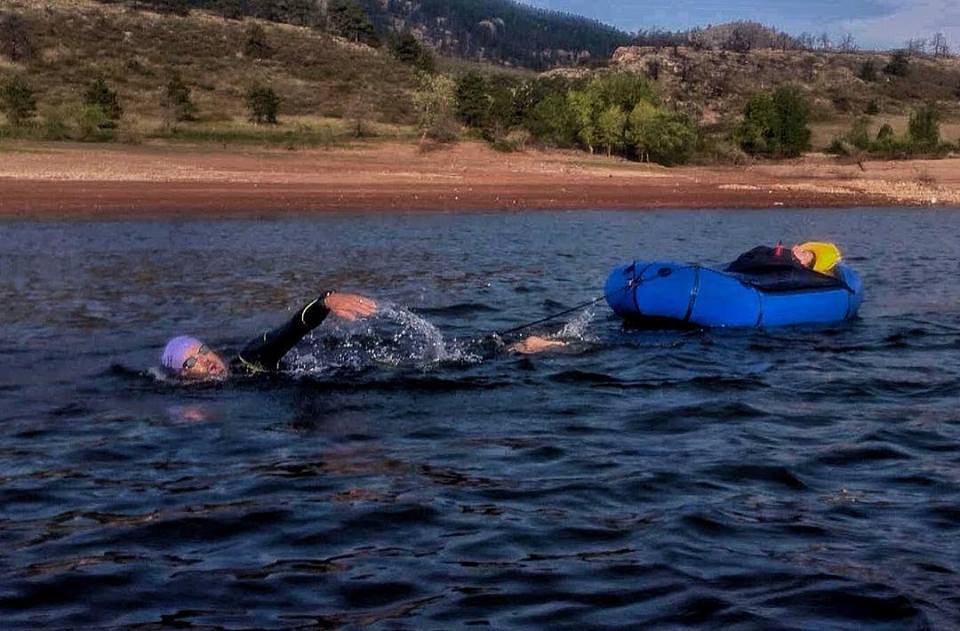As most endurance athletes near the finish line of a race, they relish in the applause and cheers from onlookers and use it to close out their sweaty efforts with a bang. But when Dave Sheanin, a 49-year old triathlete from Erie, Colorado, closes in on a finish line, he prefers the crowd’s attention be on the person directly in front of him.
Sheanin isn’t hoping another athlete will edge him out right before the finish line; instead, he’s acting as the engine behind his Athletes in Tandem partners as they swim, bike and run to countless finish lines as a pair. Athletes in Tandem (or AiT) is an organization that focuses on cycling, running and triathlon events, pairing endurance athletes with those who require use of adaptive equipment to participate in these activities.
For example, an athlete with Cerebral Palsy or another movement disorder can be part of a two-person team by being pushed in a run stroller, pulled on a bike trailer and in a raft. Sheanin has been paired with eight different partners over the past six years and has completed a couple dozen events — averaging 3–5 events per year.
“It’s so motivating, especially when the other athlete’s whole family and friends come out to cheer them on,” he says. “I have a number of finish line pictures where I’m looking pained and my partner is obviously enjoying all the cheering and feeling so happy. I love those.”
GIVING BACK
Sheanin is a lifelong athlete, particularly when it comes to running and swimming. As a kid, he tried all the “ball sports” (baseball, football and basketball) and jokes that he “sucked equally at all of them.”
But in high school, he walked onto the swim team and discovered a sport he could finally do fairly well. In college, he wasn’t quite fast enough to make Division I, but he signed up for a triathlon — and it didn’t take long before he was hooked.
“My first race was a total disaster,” he says, with a laugh. “I was so underprepared. There was no internet and the library only had one book on triathlon training, so I’d check it out every three weeks.” He walked most of the 10K run [the last leg of the triathlon] and had to take a nap in his car when it was done, but he couldn’t wait for the next one.
Once he got into the rhythm of training and racing, he was still having fun, but felt like he was hitting a plateau. Although his times continued to improve, he wanted to do more to give back to the sport, so he began coaching. When he learned about AiT in 2012, he knew it was just what he’d wanted to make a difference.
“I was in as soon as I heard about it,” Sheanin recalls. “I knew it could deepen my connection to the sport and to the community and that my actions would have a big impact on these athletes.”

TRAINING STYLE
For most people, completing a triathlon is enough of a challenge. Imagine doing the swim with a raft attached to you, then pulling a trailer on your bike and, finally, pushing a jogging stroller in front of you as you run.
The swim is around 15 percent harder than competing alone, Sheanin says, and the run is 20 percent harder. But it’s the biking that’s really tough — he estimates that it’s twice as hard. And, he adds, it’s completely worth the extra effort.
“It’s a totally different experience because you’re no longer racing for yourself,” he says. “It’s not about your time anymore or your speed; it’s really about finishing. When you see how excited your partner is to be part of the event, there’s no way you’re going to quit.”
According to Sheanin, part of what inspires him to keep signing up for paired races is seeing his partner become the center of attention. People along the race ask the name of his athlete partner and cheer that person on. It’s an incredible opportunity to do a sport he loves and to support those with mobility impairments at the same time.
“My partners get to be stars at every event,” he says. “Who wouldn’t feel inspired by that?”




